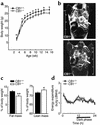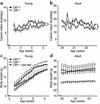The endogenous cannabinoid system affects energy balance via central orexigenic drive and peripheral lipogenesis
- PMID: 12897210
- PMCID: PMC166293
- DOI: 10.1172/JCI17725
The endogenous cannabinoid system affects energy balance via central orexigenic drive and peripheral lipogenesis
Abstract
The cannabinoid receptor type 1 (CB1) and its endogenous ligands, the endocannabinoids, are involved in the regulation of food intake. Here we show that the lack of CB1 in mice with a disrupted CB1 gene causes hypophagia and leanness. As compared with WT (CB1+/+) littermates, mice lacking CB1 (CB1-/-) exhibited reduced spontaneous caloric intake and, as a consequence of reduced total fat mass, decreased body weight. In young CB1-/- mice, the lean phenotype is predominantly caused by decreased caloric intake, whereas in adult CB1-/- mice, metabolic factors appear to contribute to the lean phenotype. No significant differences between genotypes were detected regarding locomotor activity, body temperature, or energy expenditure. Hypothalamic CB1 mRNA was found to be coexpressed with neuropeptides known to modulate food intake, such as corticotropin-releasing hormone (CRH), cocaine-amphetamine-regulated transcript (CART), melanin-concentrating hormone (MCH), and preproorexin, indicating a possible role for endocannabinoid receptors within central networks governing appetite. CB1-/- mice showed significantly increased CRH mRNA levels in the paraventricular nucleus and reduced CART mRNA levels in the dorsomedial and lateral hypothalamic areas. CB1 was also detected in epidydimal mouse adipocytes, and CB1-specific activation enhanced lipogenesis in primary adipocyte cultures. Our results indicate that the cannabinoid system is an essential endogenous regulator of energy homeostasis via central orexigenic as well as peripheral lipogenic mechanisms and might therefore represent a promising target to treat diseases characterized by impaired energy balance.
Figures





Comment in
-
Endocannabinoids and the regulation of body fat: the smoke is clearing.J Clin Invest. 2003 Aug;112(3):323-6. doi: 10.1172/JCI19376. J Clin Invest. 2003. PMID: 12897199 Free PMC article.
References
-
- Flegal KM, Carroll MD, Ogden CL, Johnson CL. Prevalence and trends in obesity among US adults, 1999-2000. JAMA. 2002;288:1723–1727. - PubMed
-
- Yanovski SZ, Yanovski JA. Obesity. N. Engl. J. Med. 2002;346:591–602. - PubMed
-
- Zhang Y, et al. Positional cloning of the mouse obese gene and its human homologue. Nature. 1994;372:425–432. - PubMed
-
- Howlett AC, et al. International Union of Pharmacology. XXVII. Classification of cannabinoid receptors. Pharmacol. Rev. 2002;54:161–202. - PubMed
-
- Lutz B. Molecular biology of cannabinoid receptors. Prostaglandins Leukot. Essent. Fatty Acids. 2002;66:123–142. - PubMed
MeSH terms
Substances
LinkOut - more resources
Full Text Sources
Other Literature Sources
Molecular Biology Databases
Research Materials

